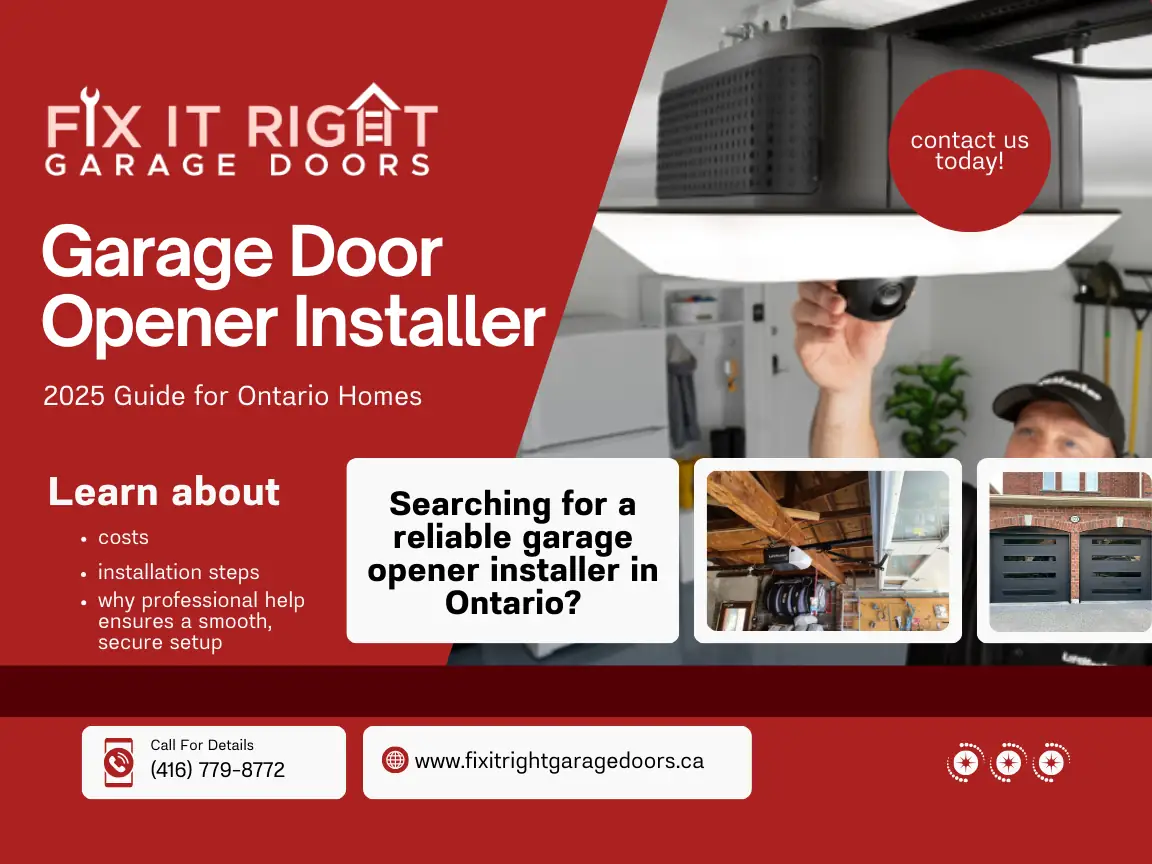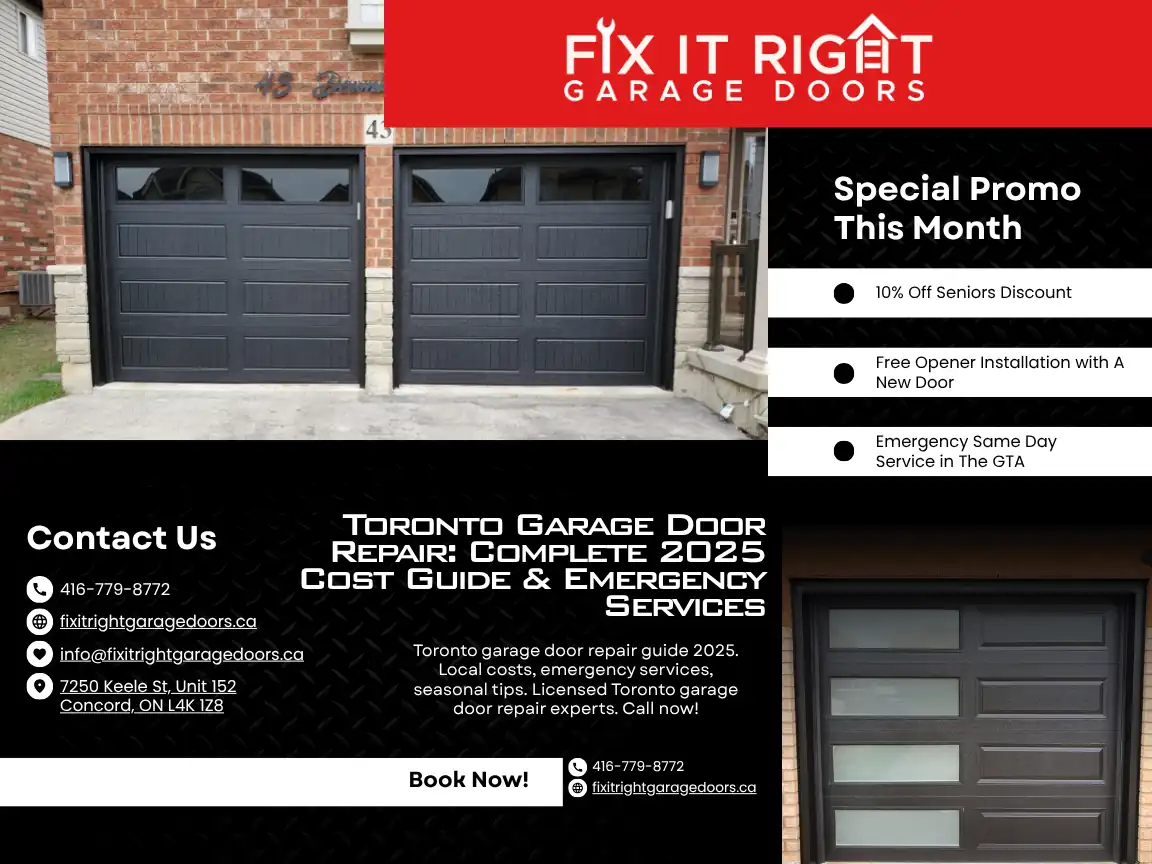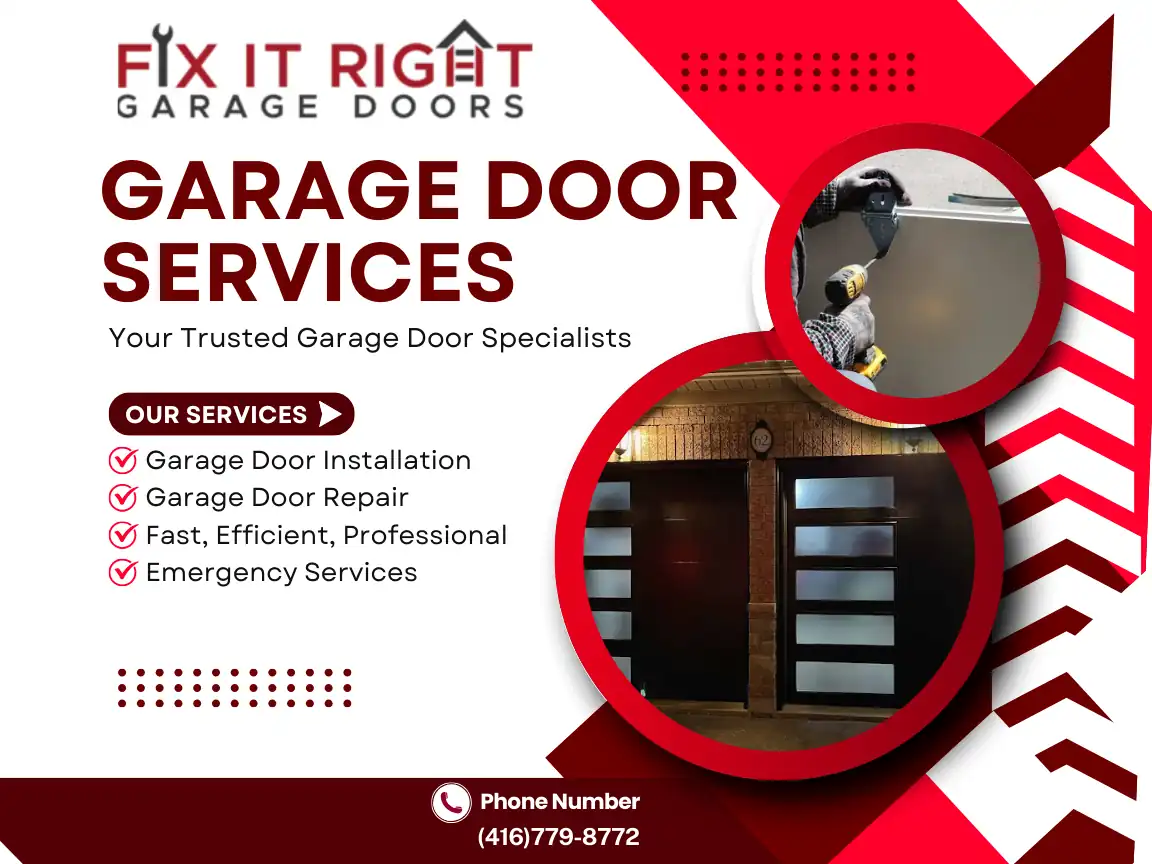If you’re on the hunt for a garage door opener installer in Ontario, you’ve come to the right place. In this 2025 Guide for Ontario Homes, we’ll cover everything from cost considerations to cutting-edge features, including advice on finding an affordable garage door opener installer who meets local regulations. We’ll also discuss professional garage door opener installation in Ontario, why it might be beneficial to rely on experts, and how to tackle DIY garage door opener installation steps if you enjoy hands-on projects.
With our evolving climate here in Canada, it’s also crucial to look for the best garage door opener for Canadian winters—one that withstands chilly nights and heavy snowfalls. After all, you don’t want to deal with a frozen or unreliable garage door when you’re already running late in the morning! So grab a warm drink, settle in, and let’s explore how to ensure a smooth, secure setup for your home.
Pro Tip: From energy-saving features to advanced security, the garage door opener market has expanded rapidly in recent years. By understanding both the technical and practical aspects, you’ll be in a great position to make a wise investment.
Ontario’s Evolving Garage Door Standards
Stricter Safety Requirements
Ontario’s building regulations have been updated to place more emphasis on safety features—like motion sensors and auto-reverse mechanisms—especially when it comes to garage doors. It’s not just about convenience anymore; it’s about protecting your family from mishaps and ensuring your property meets the latest rules.
- Motion Sensors: Modern systems detect even the slightest movement near the door, automatically halting its operation.
- Auto-Reverse Mechanisms: If the door encounters an obstacle, it will reverse direction, reducing the risk of accidents.
- Real-World Example: Susan from Toronto replaced her older chain-drive opener with a belt-drive model equipped with robust safety sensors. The new system reversed mid-close when her dog wandered under the door, preventing any potential harm.
Building Codes and Compliance
If you’ve owned a home in Ontario for a while, you might recall that garage door safety wasn’t always such a big deal. However, as of 2025, local governments are cracking down on outdated systems.
- Inspection Readiness: Some municipalities may require an inspection to verify that your garage door setup meets updated codes.
- Compliance Papers: Professionals can provide the paperwork often needed if you decide to sell or refinance your home.
- Why This Matters: A garage door opener installer who’s familiar with current building codes can help ensure that you’re not only safe but also fully compliant.
Pro Tip: Looking for more details? Check out the Ontario Building Code Guidelines for official information on structural and safety standards.


What to Expect from a Garage Door Opener Installer in 2025
Hiring a garage door opener installer isn’t just about handing over a device and letting someone else do the grunt work. It’s about ensuring you have a perfectly balanced, smoothly operating system that can handle Ontario’s unique challenges—think frigid winters and sudden weather changes.
Initial Assessment and Quote
When you call a professional, the first step often includes an on-site evaluation. They’ll measure your garage dimensions, inspect the existing track and spring system, and assess whether upgrades are needed. Commonly, they also discuss:
- Type of Drive: Chain, belt, screw, or direct drive.
- Motor Horsepower: Adequate for the weight of your garage door.
- Smart Features: Wi-Fi connectivity, battery backup, or integration with home automation systems.
Real-World Example: Marco in Sudbury requested quotes from two different companies. One offered a generic chain-drive opener with minimal features, while another recommended a belt-drive system with a Wi-Fi module, perfect for Marco’s love of smart home gadgets.
Installation Timeline and Steps
A seasoned garage door opener installer typically completes the job within a few hours if no extensive modifications are needed. Here’s a quick look at what they’ll do:
- Detach Old Opener: Remove the outdated system if present.
- Secure the Brackets: Mount new brackets for the rails and motor.
- Install Safety Sensors: Align the sensors accurately on either side of the garage door.
- Wire Up the Motor: Connect power and ensure any smart features are operational.
- Test and Tweak: Run several open-and-close cycles to check for smooth movement.
Practical Implementation: If your installer notices any structural issues—like a warped track or worn springs—they’ll advise you to fix those before finishing the opener installation. This ensures the new system isn’t compromised by pre-existing damage.
Post-Installation Advice
Professionals will typically walk you through how to maintain your new opener:
- Lubrication: Keep metal components (chains, rollers) properly lubricated to minimize friction and noise.
- Safety Checks: Test the auto-reverse function monthly.
- Routine Maintenance: Schedule a yearly tune-up to keep your warranty valid and your opener running optimally.
Pro Tip: Many garage door opener installer packages in 2025 come with extended service plans, which can be a lifesaver if something goes awry during the harsh winter months.
Choosing the Best Garage Door Opener for Canadian Winters
Why Winter Performance Matters
Living in Ontario means dealing with extreme cold, freezing rain, and heavy snow. Your garage door opener has to endure these conditions while still working reliably. That’s why finding the best garage door opener for Canadian winters is crucial for local homeowners.
Winter-Friendly Features
- Thermal Lubricants: Designed to remain viscous in sub-zero temperatures, preventing friction damage.
- High-Horsepower Motors: A more powerful motor works efficiently even when the door’s hinges and tracks are slightly stiff from the cold.
- Battery Backup: This feature is invaluable during winter storms that lead to power outages.
- Steel-Reinforced Belts: A belt-drive opener reinforced with steel is often quieter and more durable in frigid weather than a standard chain.
Real-World Example: Jessica from Thunder Bay upgraded her opener after multiple breakdowns each winter. Her new belt-drive system with a high-torque motor continued to lift smoothly, even during January’s -25°C temperatures.
Smart Tech: A Game-Changer in the Snow
- Remote Monitoring: Forgot to close the garage door while rushing out in bad weather? Just check your smartphone app.
- Voice Control: Integrate with Google Assistant or Alexa to open your garage without fumbling for a remote when you come in with armfuls of groceries.
- Scheduled Operation: Set the door to auto-lock at night, boosting security when winter conditions make external checks challenging.
Pro Tip: Opt for systems that send you alerts if the door remains open for an extended period—ideal if you’re away on a ski trip.
Weighing DIY Garage Door Opener Installation Steps vs. Professional Help
The Allure of DIY
If you’re a handy homeowner, the concept of tackling DIY garage door opener installation steps might sound appealing. Some of the advantages include:
- Cost Savings: Eliminate labor fees by doing it yourself.
- Learning Opportunity: Gain insights into how your garage door system works.
- Schedule Flexibility: Work on the project whenever you have free time.
Practical Implementation: Start by reading the manufacturer’s instructions thoroughly. Gather all necessary tools—wrenches, drills, ladders—and check that you have the correct hardware.
Potential Pitfalls of DIY
However, the DIY route isn’t without risks, especially if you lack experience:
- Safety Hazards: Garage doors can be heavy, and springs are tension-loaded. One slip can be dangerous.
- Voided Warranties: Many manufacturers only honor warranties if a certified technician handles the installation.
- Time Investment: What a pro can do in 2-3 hours might take you an entire weekend, or longer if unexpected issues arise.
- Alignment Issues: Sensors, rails, and brackets need precise calibration. One small error can result in repeated malfunctions.
Real-World Example: Daniel in Markham attempted a DIY install. He ended up misaligning the door’s photo-eye sensors, causing constant error beeps and incomplete closes. A garage door opener installer he eventually hired fixed the issue in 15 minutes.
The Case for a Professional Garage Door Opener Installer
Considering the complexity and potential for costly mistakes, many homeowners choose professional garage door opener installation in Ontario:
- Full Compliance: A pro ensures your door meets all local building codes.
- Peace of Mind: Focus on other tasks while an expert handles the tricky parts.
- Post-Installation Support: If something goes wrong, they’ll likely cover repairs under warranty.
- Efficiency: Less downtime and a reduced risk of repeated adjustments.
Pro Tip: Ultimately, the choice boils down to balancing cost with peace of mind. If you value reliability and don’t want to risk future repair bills, hiring an affordable garage door opener installer can be the wiser route.
Cost Breakdown for Garage Door Opener Installation
Whether you decide to go DIY or hire a garage door opener installer, it’s crucial to budget properly. Below is a handy reference table outlining typical expenses in Ontario. Keep in mind, these are rough estimates and can vary based on location, brand, and additional features.
| Expense Item | Approximate Cost (CAD) |
|---|---|
| Basic Chain-Drive Opener | $350 – $450 |
| Upgraded Belt-Drive Opener | $450 – $650 |
| Smart/Wi-Fi Feature Add-On | $100 – $200 |
| Professional Labor | $150 – $300 |
| Optional Battery Backup | $100 – $150 |
Factors Affecting Final Costs
- Opener Type: Chain-drive is cheaper but noisier; belt-drive is quieter but pricier.
- Brand and Warranty: Top-tier brands come with extended warranties.
- Complex Installation: If your garage is large or has unique structural needs, expect higher labor fees.
- Electronics and Add-Ons: Smart features, sensors, and backup batteries can add to the bill.
Real-World Example: Helene in Ottawa opted for a premium LiftMaster belt-drive opener with Wi-Fi connectivity and battery backup. She paid around $650 for the opener and $250 for the professional install, but the peace of mind was worth every penny.
Saving Money Without Sacrificing Quality
If you’re concerned about your budget, look for an affordable garage door opener installer who offers package deals. Some companies even provide free annual check-ups or discounts on future repairs.
- Bundle Discounts: Installing two garage door openers at once or combining opener installation with other garage services can lower costs.
- Seasonal Promotions: Certain times of the year—like late fall—may have discounts to encourage pre-winter upgrades.
- Financing Plans: Some installers offer payment plans that spread out the cost, making a high-quality opener more accessible.
Maintenance Tips for a Long-Lasting System
Once you have your brand-new opener installed—whether you tackled those DIY garage door opener installation steps or hired a pro—you’ll want to keep it in tip-top shape.
Regular Lubrication
- Recommended Products: Use silicone-based lubricants rather than grease, which can gum up in cold weather.
- Frequency: Lubricate rollers, hinges, and springs every six months, or more often in extremely cold conditions.
Sensor Alignment Checks
- Visual Inspection: Ensure no debris is blocking the sensor path.
- Test Monthly: Wave an object in front of the beam while the door is closing—if the door doesn’t reverse, realign or replace sensors.
Battery Backup and Power
- Check Battery Life: If you have a backup battery, test it at least twice a year.
- Electrical Connections: Inspect the power cord and outlet for damage or wear.
Real-World Example: Barry from Windsor noticed his door slowing down mid-lift. A quick inspection revealed a loose bracket and inadequate lubrication. After tightening the bracket and applying silicone lubricant, his opener resumed its smooth operation.
Enhancing Your Garage Space Beyond the Opener
Your garage door opener is just one piece of the puzzle. Consider transforming your entire garage into a multi-functional space:
- Insulated Garage Doors: Enhance energy efficiency, especially useful if you use the space as a workshop.
- Smart Home Integration: Tie in security cameras or motion sensors that link to your garage opener’s app.
- Storage Solutions: Overhead racks and wall-mounted shelves keep the floor clear, allowing the door to operate unhindered.
- Upgraded Lighting: LED fixtures provide bright, energy-efficient illumination, making it safer to come and go at night.
Practical Implementation: Bundle these upgrades when hiring a professional garage door opener installation in Ontario—sometimes installers can tackle multiple tasks in a single visit, saving time and possibly cost.
Why Professional Expertise Matters
In a perfect world, a garage door opener would be a “set it and forget it” appliance. Yet, Ontario’s climate and evolving regulations make garage door opener installer expertise crucial.
- Regulation Compliance: Pros know the ins and outs of local codes.
- Safety Assurance: A poorly tensioned spring can pose serious hazards.
- Efficiency Gains: Experts complete installations faster and with minimal disruption.
- Warranty Protection: Many manufacturers only honor warranties if a certified technician does the work.
Conclusion Link: If you’re ready for a smooth, secure setup, check out Fix It Right Garage Doors. They specialize in professional garage door opener installation in Ontario, ensuring your family’s safety and your home’s compliance with the latest standards.
Conclusion: Secure and Future-Proof Your Garage Door
A reliable garage door opener is about more than just convenience. It’s about safety, peace of mind, and adapting to the future of smart home technology. Whether you decide on DIY garage door opener installation steps or opt for an affordable garage door opener installer, knowledge is your best tool for making informed choices.
Thought-Provoking Questions:
- Have you considered the potential risks of a DIY approach versus the reassurance of a professional setup?
- Which smart features would genuinely improve your lifestyle, and which might be unnecessary extras?
- Does your current garage door opener meet the standards required to protect your family and valuables in 2025 and beyond?
Let us know your thoughts in the comments below! By investing in the best garage door opener for Canadian winters and ensuring top installation, you’ll be ready to tackle everything Ontario’s climate can throw your way. ❄️










